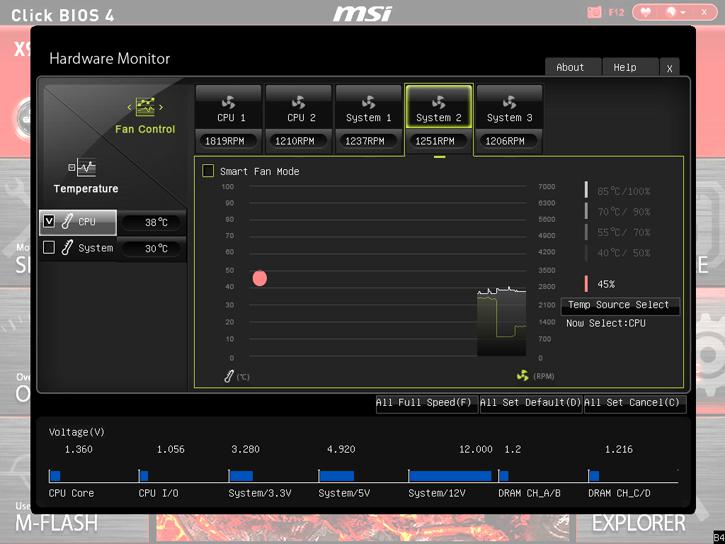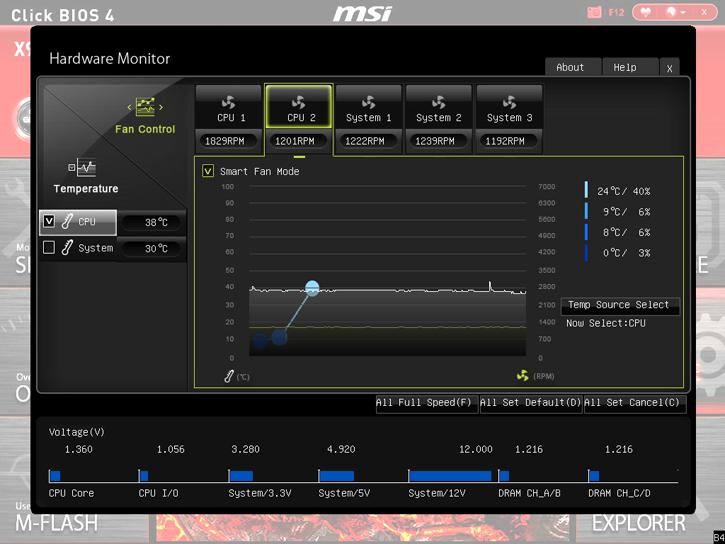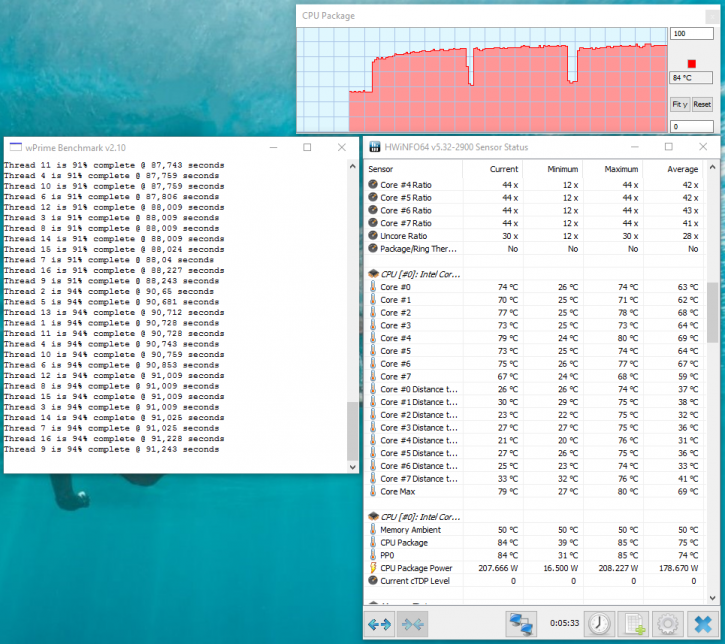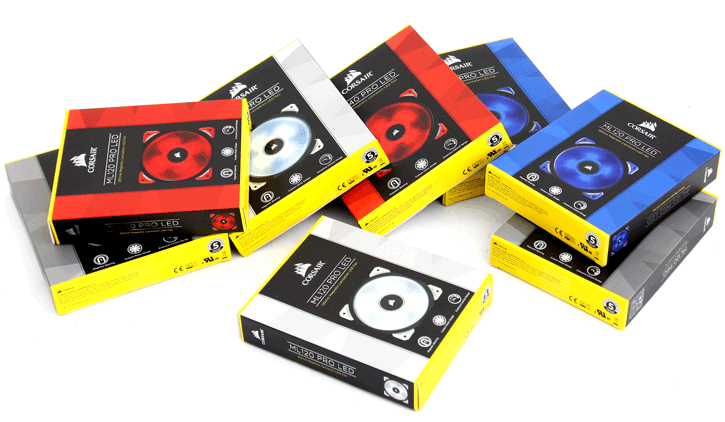Article Page 2 - The Quick test
Magnetic Levitating Fans - A quick test
So as stated, we are not a website that tests fans (at all). If you are deeply and profoundly into airflow measurements by all means find a website that does spend time on it. I do care about aesthetics and basics though, fans must last, must be silent must offer good enough airflow and the ML fans do offer all that if you grant it the right conditions. And that does mean you'll need to seek a sweet spot on fan RPM.
Seeking the right conditions - if you are about silence, you MUST RPM control these fans. Your sweet spot will be running to up-to 1250 RPM max. On the motherboard simply connect the fan towards whatever you want it used for. In the BIOS you can set profiles based on PWM for these fans. After testing for about 10 minutes I decided that op-to 40 to 50% RPM (max 1250~1300 RPM) the ML series are silent, after that value you can hear them. At 1200 RPM we reached 35~36 DBa of measured noise. But at a totally silent level, say 1000~1100 RPM / 33 DBa the airflow these things create still is pretty amazing. Maxed out (2400 RPM) they are loud. When you crank them all the way up I swear it though, you can cool an entire room as I can feel a breeze from one 120mm fan like one and a half meters away. But they do become too loud.
Let me show you something:
It probably is the worst test ever, but above you can see a thermal image of a graphics card in total stress. It is running 3DMark FireStrike looped in scene 1. Have a close look at the temperatures that the PCB areas reach, in specific you can see that the VRM zone reaches 93 Degrees C. Now we simply place a 120mm ML Pro fan on top of the graphics card, it's running 45% RPM which on our motherboard results towards a silent 1250 RPM -check out what happens after a few minutes of airflow:
Above the same card and same conditions. Compare the thermal images back and forth a little and you will notice that the increased (silent) airflow manages to cool down the same VRM area by roughly 20 Degrees C. Again, this is a worthless test but a plausible one as it shows the terrific airflow these fans offer. Another test I ran. Our VGA test system is cooled with a Corsair H105 Liquid cooler and is cooling an 8-core (16 threads) Core i7 5960X overclocked to 4.4 GHz. That's quite a bit of heat to deal with with Haswell-E. I program a fixed RPM at ~1200 RPM with the default cooler and fans like so:
Above Corsair H105 with default fans @ 1200 RPM
Above Corsair H105 with two ML Pro series fans @ 1200 RPM
Now I fired up the Wprime stress test with 16 threads and ran it 3 times as the result show above. The temps in-between the two tests is close to NIL in regards to difference. This means the cooler is maxed out cooling wise (it's a simple LCS kit) + Haswell-E processors are bitchy like that with that crappy thermal heat-spreader.
Examples of Sounds Levels
| Mjorgenson's Wife | 130 dBA | Excruciating |
| Jet takeoff (200 feet) | 120 dBA | |
| Construction Site | 110 dBA | Intolerable |
| Shout (5 feet) | 100 dBA | |
| Heavy truck (50 feet) | 90 dBA | Very noisy |
| Urban street | 80 dBA | |
| Automobile interior | 70 dBA | Noisy |
| Normal conversation (3 feet) | 60 dBA | |
| Office, classroom | 50 dBA | Moderate |
| Living room | 40 dBA | |
| Bedroom at night | 30 dBA | Quiet |
| Broadcast studio | 20 dBA | |
| Rustling leaves | 10 dBA | Barely audible |
There are a lot of differences in measurements among websites. Some even place the dBA meter 10 cm away from the card. Considering that's not where your ear is located, we do it our way, at 50 cm distance.
So why am I bringing the test up if the temps are the same ? Well, the cherry on top of this cake is not the increased airflow (which is there) but it's the lower noise level. Under full CPU stress at 1200 RPM the default H105 fans ooze out roughly 38~39 DBa of noise (which is already relativity silent tbh). However the ML Series 120mm fans however stick at roughly 35~36 DBa. The end-result is that not only we get a little more airflow (albeit that is not measurable in the actual CPU temperature), they are more silent as well.
Concluding
That is all the time I have for this petite mini review on the ML series fans. These fans truly are pretty impressive, but also pretty expensive - I'll acknowledge you that. Corsair back them with a 5 year warranty though and with a design that has virtually no friction, they could probably last a life-time. If too expensive, my advise, have a peek at the non PRO models and just use say two on your liquid cooling setup. Though they will not have the rubberized exchangeable corners, the 120mm models then are 15 bucks a pop and 20 bucks a pop for the 140mm models. Keep in mind that Corsair is giving you a huge range in RPM, and that goes from silent to loud. The one requirement is that you need to regulate fan RPM at a maximum of your personal preference, we say that is roughly 1250 RPM. Anything above that RPM value will become noisy quickly as airflow inherently and simply always will make create noise. At full blast 100% RPM you can feel the airflow like 2 meters away from these fans, they are that powerful. That's it for this quick write-up. Again reviewing fans is not my thing, but I do know that the ML fans are incredibly impressive. I am sure other media outlets will have in-depth airflow tests etc. That's just not my cup of tea, so please see this article as a bit of an informative read on Coresir's latest and greatest fans. Highly recommended.
- H to the H








